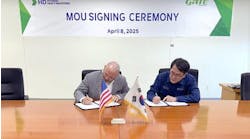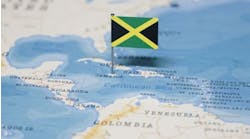Visionarium opens Statoil's way to a multidisciplinary future
Tearing down the fences
The visionarium - a highway into a more efficient future, Statoil hopes."Today, we will witness a technological breakthrough: true remote collaboration based on 3D visual communication technology, which aims at improving strongly the quality and timeliness of the technical basis of our business decisions."
Thus spoke Harald Norvik, Statoil's chief executive, at the opening last November of the company's NKr 15 million Advanced Visualisa tion Centre (AVC) in Stavanger. As he suggested, Statoil has high hopes of the returns this project will bring in terms of improving reservoir understanding and decision-making, and ultimately cost-effective operations.
The visualization project forms part of a wider initiative whereby Statoil is aiming to make substantial improvements in the quality of subsurface related work processes. The goals of the so-called Score project include improving prognosis quality by a factor of two, reducing the time for model-building by a factor of two, and achieving value creation of NKr 5-7 billion in five years.
A number of partners are involved with Statoil in the visualisation project:
- Silicon Graphics is supplying the hardware
- Landmark Graphics is developing the software for the common database
- Tan Technologies is supplying the projection technology.
Reservoir data
In the AVC or visionarium, a 3D model of the reservoir is presented which incorporates all data relating to the reservoir transported onto a common platform. Viewers - there is seating for 20 - wear stereo vision glasses to get the 3D effect. The model can be rotated so that it can be viewed from different perspectives. Selected areas can be zoomed in on.Color is used to represent the depth values of the various reservoir layers, while the colors draped over the top indicate the porosity. Well paths drilled into the reservoir are shown, and the logs relating to each well can be called up alongside them.
The images are presented on a curved screen. This mode was chosen rather than the cave concept, in which the viewer is completely surrounded by the reservoir image, as it suits the company's purposes better, and especially the need to have interdisciplinary groups working together.
Full team involvement
"We wanted to be able to cope with a full suite of people who work with the model," says Trond Berg , the center's manager. "The visionarium also gives you some of the features of the cave, such as allowing you to immerse yourself in the model."The early phases of the project have seen great efforts made to put the various kinds of subsurface data on a common database which serves as the basis for the integrated platform for the visualisation process. The integrated platform is provided by Landmark's OpenWorks system, while its OpenVision is the integrated visualisation tool.
Putting all the data on the same database is itself an important advance, Berg says. In the early days a lot of time was spent looking for data, and when it was found, it was often in the wrong format. Now it can be made visually available in an integrated fashion.
New ways of working
To realize the full potential of the technology, new ways of working together based on interdisciplinary teamwork are called for. As Norvik himself said at the opening, "In order to find and produce more oil and gas, we have to tear down the fences between professionals."The fences have constituted a big problem in the past, as Berg explains. "Traditionally there has been a lot of going back and forth between the different discipline groups, and it's all been very time-consuming. Now, we can bring everybody to the center, and if, for example, it's a new well that has to be planned, the drilling engineer can see the situation in full 3D and get a much better grasp of the problems involved in designing the well. The other discipline groups can make their contributions and now we can probably sort it all out in a day rather than a week."
In the not too distant future, Berg says, it should be possible to link the drilling operation itself to the center, and monitor the data in real-time. Techniques such as geo-steering will become much easier, and drilling will become much more cost-effective.
Global link-up
Meanwhile all those involved in Statoil's subsurface activities do not have to come to Stavanger to enjoy the advantages of the visionarium. At the opening of the center, a live link-up was made with Landmark's Houston office where the same model was being displayed. Eventually, Statoil aims to have visualization centers at its key locations around the world, so that subsurface problems can be simultaneously tackled by teams which bring together the requisite experts, wherever they may be based. The experience is thus a sort of logical extension of the video conference."Remote cooperation in this way is a very efficient tool," says Berg . "For example, we can do quality assurance of data without having to send people across the globe."
Part of the power of visualization technology is that it makes use of the strongest human sense. Trying to appreciate the significance of two related sets on data in written form is often difficult, but the significance may become very clear when they are modeled.
"Having the data available in large-scale 3D displays makes a big difference," Berg says. "It's much easier to understand what the seismic means. You can relate it to depth - everyone discusses depth values. The technology provides a common ground for discussion, which is very good. And I think we've only seen the beginning. There is an enormous potential for subsurface work here."
As part of the project, the possibility is being investigated of combining the visual input with sound to see whether advantage can be taken of the human ability to process multiple.
Data from all the company's fields are now being put on to common databases, a mammoth task involving 75 separate projects. For some fields, there is an immense amount of data to be entered. For Statfjord alone, there are over 100 maps. But, by year-end all these projects should be implemented, at which point the visionarium is likely to start becoming a very busy place.
Tools for the future
Future work also includes the development of a full suite of tools to enable the model to be used in planning subsurface activities. A couple of tools already exist - wellbore manager, a completion design system, and wellbore planner, a wellpath planning system.Using the latter tool, the targets for the well are marked on the model and the tool then plots a smooth well path between them. The drilling engineer can examine the wellpath in the light of the technical features and decide how drillable it is.
The technology is also interesting for disciplines such as platform design, process plant design, and pipelay planning, says Berg . For pipelay engineers, it can be quite an eye-opener to see the seabed on which they are planning to install a pipeline in 3D detail.
For architectural usage, the technology enables buildings or platforms to be brought up in one-to-one scale and a walk to be taken through them. It is easy to see where features clash or do not relate to each other as the designer intended.
Some early work has also been done on incorporating 4D seismic data. Data from seismic surveys acquired on the Gullfaks Field in 1985 and 1995 has been put through the same processing, enabling seismic cubes to be created for each. From these, a differential cube can be extracted, showing how the gas/liquid and oil/water contacts have moved.
The process already has led to some interesting observations, Berg says. It indicates, for example, that there is more compartmentalization of the reservoir than previously supposed. Minor faults need to be mapped very accurately, as they can impede flow. High-pressure areas have been found next to low-pressure areas, even where boundaries between them had not been detected.
Copyright 1999 Oil & Gas Journal. All Rights Reserved.




